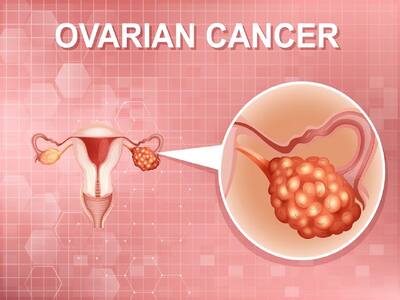
It’s easier to treat ovarian cancer when it is diagnosed in its early stages, but it’s not easy to detect its early signs and symptoms.
Globally, ovarian cancer (OC) is ranked the 8th most common cause of cancer death among women. In India, ovarian cancer is identified as the third most common gynaecological cancer. The early signs and symptoms of ovarian cancer are vague and easy to miss. Hence, most of the patients are diagnosed in advanced stage where the survival rate is poor.
Can development of ovarian cancer be prevented? It is not possible to completely eliminate the risk of developing ovarian cancer. However, taking oral birth control pills, breastfeeding, pregnancy, tubal ligation (having the fallopian tubes are cut or blocked to permanently prevent pregnancy) and hysterectomy (removal of the uterus) are known to be associated with lower risk of ovarian cancer.
In recent years, there has been a growing trend among women choosing to undergo the removal of their fallopian tubes, a procedure known as salpingectomy, as a preventative measure. Let’s understand the pros and cons of this surgical procedure.
Potential benefits of salpingectomy
“Salpingectomy during hysterectomy, has gained popularity due to its potential benefits in reducing the risk of ovarian cancer and ectopic pregnancies,” says Dr. Rohit Raghunath Ranade, Consultant Gynaecology- Oncology, Robotic Surgery, Narayana Health City Bangalore.
He elaborates, “Salpingectomy is a safe surgical procedure when performed by a skilled doctor. It involves the removal of both fallopian tubes while preserving the ovaries, which allows women to maintain their hormonal balance and fertility.”
The importance of post-operative care
After a salpingectomy, it’s essential for women to follow post-operative care instructions diligently.
According to Dr. Ranade, this typically includes taking prescribed pain medication, keeping the surgical site clean, avoiding strenuous activities for a specific period and follow-up appointments to monitor the recovery.
READ RELATED: 7 Most Authentic Dishes to Order at a Greek Restaurant, According to Chefs
“While salpingectomy can offer significant benefits for some women, the decision to undergo this procedure should always be made in consultation with a skilled doctor and specialist who can provide personalized guidance based on a woman’s medical history and risk factors,” he notes.
Risks associated withsalpingectomy
Dr Rujul Jhaveri, Consultant Gynaecologist at NH-SRCC Children’s Hospital, also underscores that the decision to remove fallopian tubes or salpingectomy should be carefully considered on an individual basis.
He says, “While this can reduce the risk of ovarian cancer and ectopic pregnancies, it has certain risks. Women with a family history of ovarian cancer, BRCA gene mutations, or a strong risk factor should consider fallopian tube removal as a preventive measure. It significantly reduces the chances of developing this often-deadly cancer. However, for women with no significant risk factors, the decision may not be as clear-cut. Removing fallopian tubes is not without risks, including surgical complications and potential impact on fertility. Women planning to conceive in the future should discuss alternative options with their doctor.”
What out for the signs and symptoms of ovarian cancer such as abdominal bloating and pain; an increase in urination, back pain, menstrual irregularities, weight loss, painful intercourse, etc.
Total Wellness is now just a click away.
Follow us on
Don’t Miss Out on the Latest Updates.
Subscribe to Our Newsletter Today!
window.addEventListener(‘load’, (event) => {
$(‘#commentbtn’).on(“click”,function(){
(function(d, s, id) { var js, fjs = d.getElementsByTagName(s)[0]; if (d.getElementById(id)) return; js = d.createElement(s); js.id = id; js.src = “//connect.facebook.net/en_US/sdk.js#xfbml=1&version=v2.3”; fjs.parentNode.insertBefore(js, fjs);}(document, ‘script’, ‘facebook-jssdk’));
$(“.cmntbox”).toggle();
});
});








